BMW 3 SERIES 2002 E46 Drive Away Protection Syst
Manufacturer: BMW, Model Year: 2002, Model line: 3 SERIES, Model: BMW 3 SERIES 2002 E46Pages: 30, PDF Size: 0.7 MB
Page 11 of 30
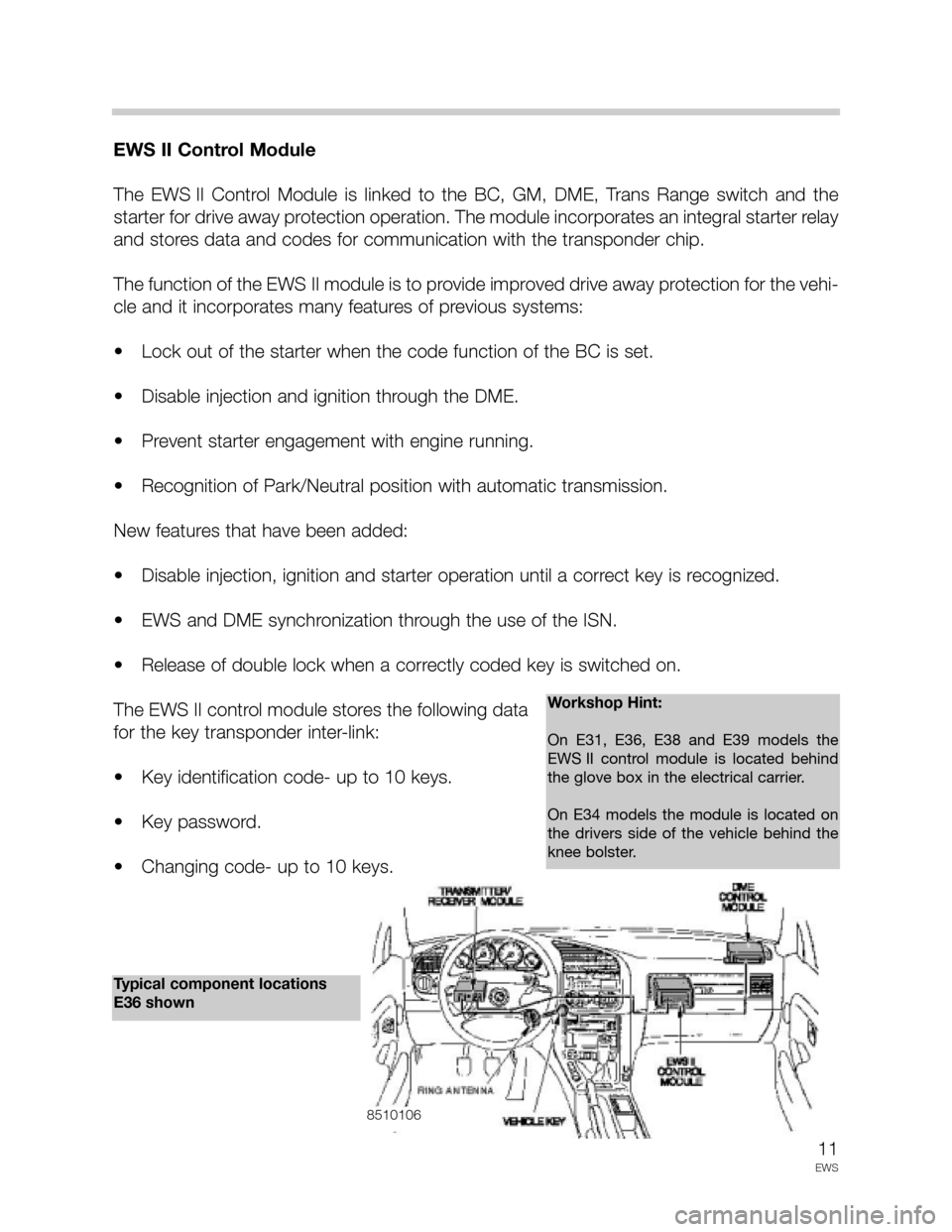
11
EWS
EWS II Control Module
The EWS II Control Module is linked to the BC, GM, DME, Trans Range switch and the
starter for drive away protection operation. The module incorporates an integral starter relay
and stores data and codes for communication with the transponder chip.
The function of the EWS II module is to provide improved drive away protection for the vehi-
cle and it incorporates many features of previous systems:
• Lock out of the starter when the code function of the BC is set.
• Disable injection and ignition through the DME.
• Prevent starter engagement with engine running.
• Recognition of Park/Neutral position with automatic transmission.
New features that have been added:
• Disable injection, ignition and starter operation until a correct key is recognized.
• EWS and DME synchronization through the use of the ISN.
• Release of double lock when a correctly coded key is switched on.
The EWS II control module stores the following data
for the key transponder inter-link:
• Key identification code- up to 10 keys.
• Key password.
• Changing code- up to 10 keys.
Workshop Hint:
On E31, E36, E38 and E39 models the
EWS II control module is located behind
the glove box in the electrical carrier.
On E34 models the module is located on
the drivers side of the vehicle behind the
knee bolster.
8510106
Typical component locations
E36 shown
Page 12 of 30
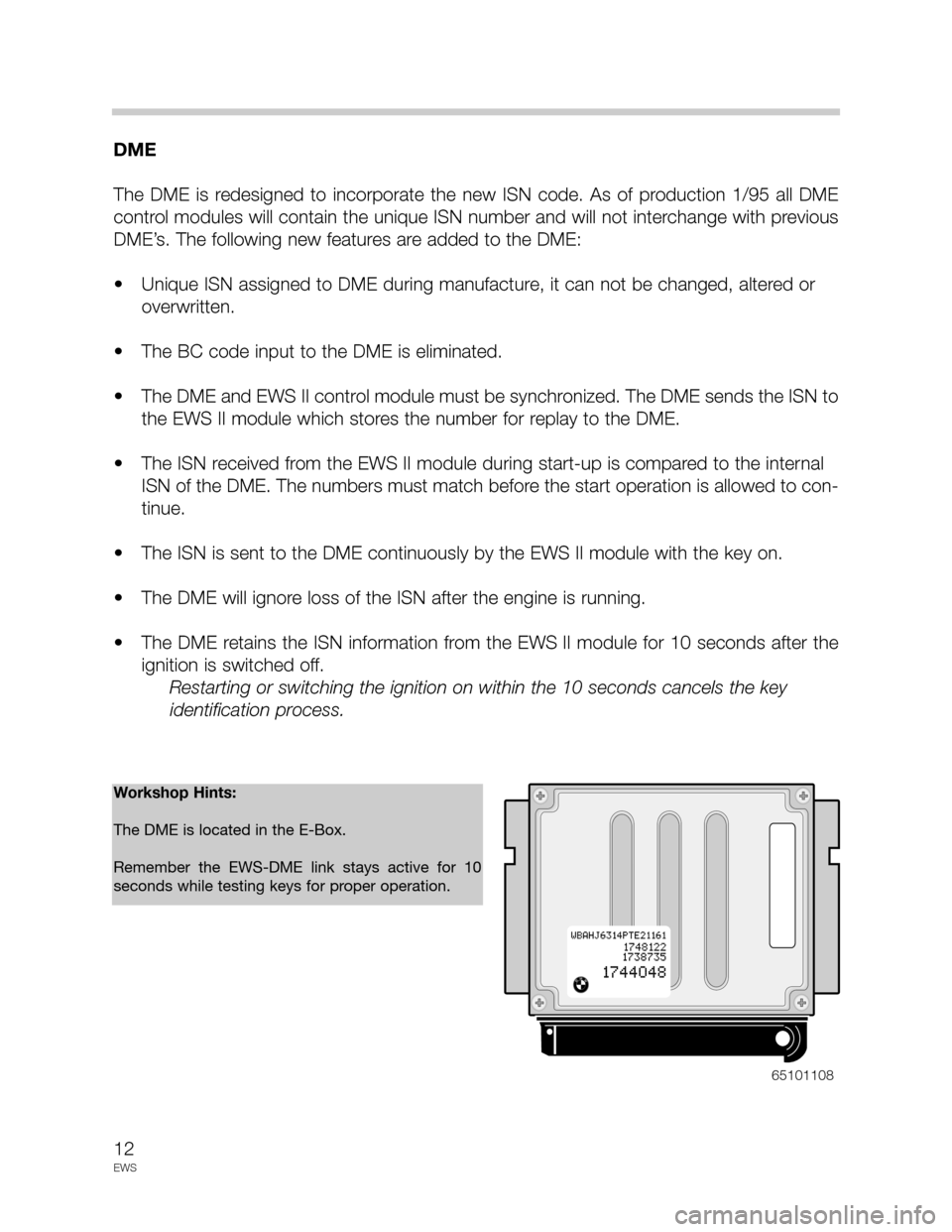
12
EWS
DME
The DME is redesigned to incorporate the new ISN code. As of production 1/95 all DME
control modules will contain the unique ISN number and will not interchange with previous
DME’s. The following new features are added to the DME:
• Unique ISN assigned to DME during manufacture, it can not be changed, altered or
overwritten.
• The BC code input to the DME is eliminated.
• The DME and EWS II control module must be synchronized. The DME sends the ISN to
the EWS II module which stores the number for replay to the DME.
• The ISN received from the EWS II module during start-up is compared to the internal
ISN of the DME. The numbers must match before the start operation is allowed to con-
tinue.
• The ISN is sent to the DME continuously by the EWS II module with the key on.
• The DME will ignore loss of the ISN after the engine is running.
• The DME retains the ISN information from the EWS II module for 10 seconds after the
ignition is switched off.
Restarting or switching the ignition on within the 10 seconds cancels the key
identification process.
Workshop Hints:
The DME is located in the E-Box.
Remember the EWS-DME link stays active for 10
seconds while testing keys for proper operation.
65101108
Page 13 of 30
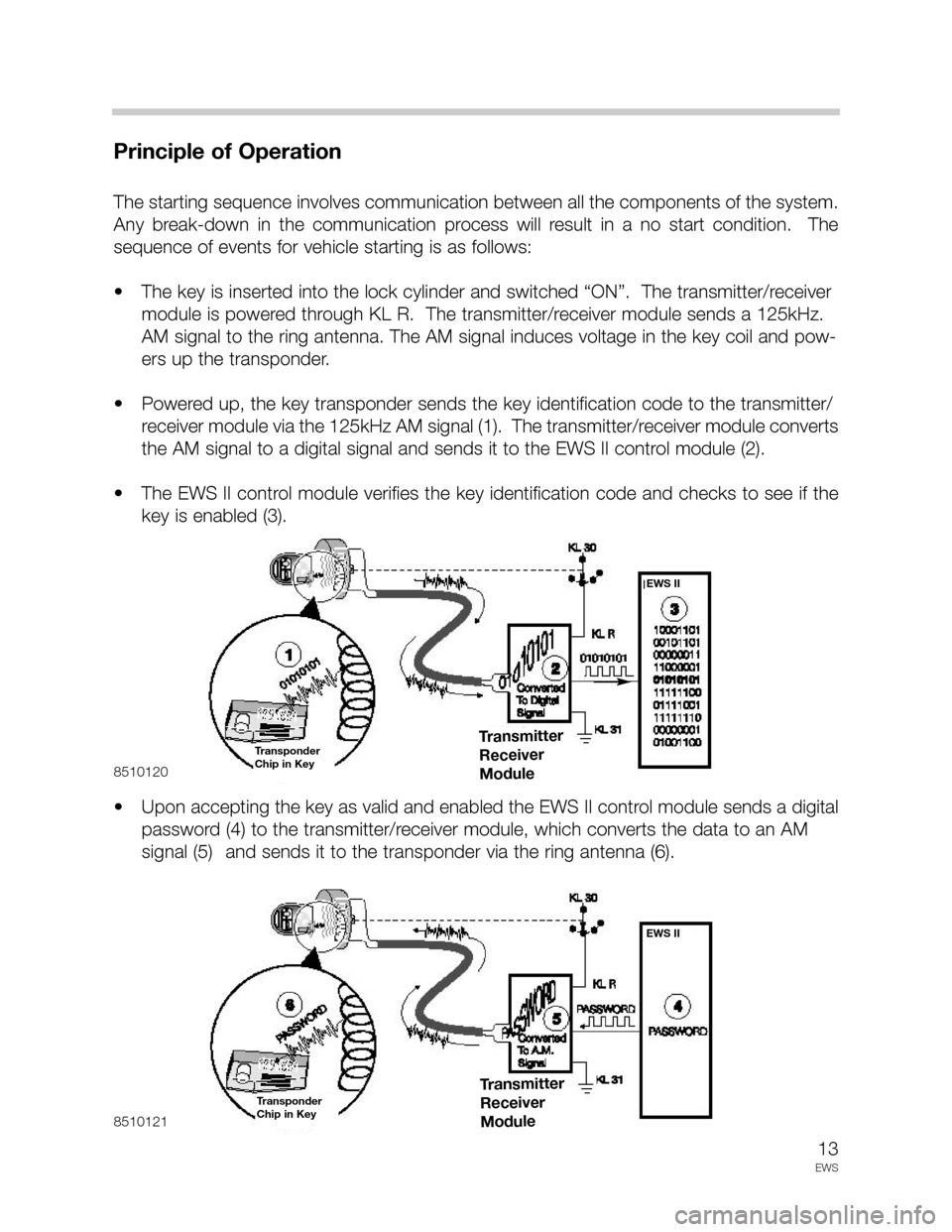
13
EWS
Principle of Operation
The starting sequence involves communication between all the components of the system.
Any break-down in the communication process will result in a no start condition. The
sequence of events for vehicle starting is as follows:
• The key is inserted into the lock cylinder and switched “ON”. The transmitter/receiver
module is powered through KL R. The transmitter/receiver module sends a 125kHz.
AM signal to the ring antenna. The AM signal induces voltage in the key coil and pow-
ers up the transponder.
• Powered up, the key transponder sends the key identification code to the transmitter/
receiver module via the 125kHz AM signal (1). The transmitter/receiver module converts
the AM signal to a digital signal and sends it to the EWS II control module (2).
• The EWS II control module verifies the key identification code and checks to see if the
key is enabled (3).
• Upon accepting the key as valid and enabled the EWS II control module sends a digital
password (4) to the transmitter/receiver module, which converts the data to an AM
signal (5) and sends it to the transponder via the ring antenna (6).
8510120
8510121
Transmitter
Receiver
Module
Transmitter
Receiver
Module
Transponder
Chip in Key
Transponder
Chip in Key
EWS II
EWS II
Page 14 of 30
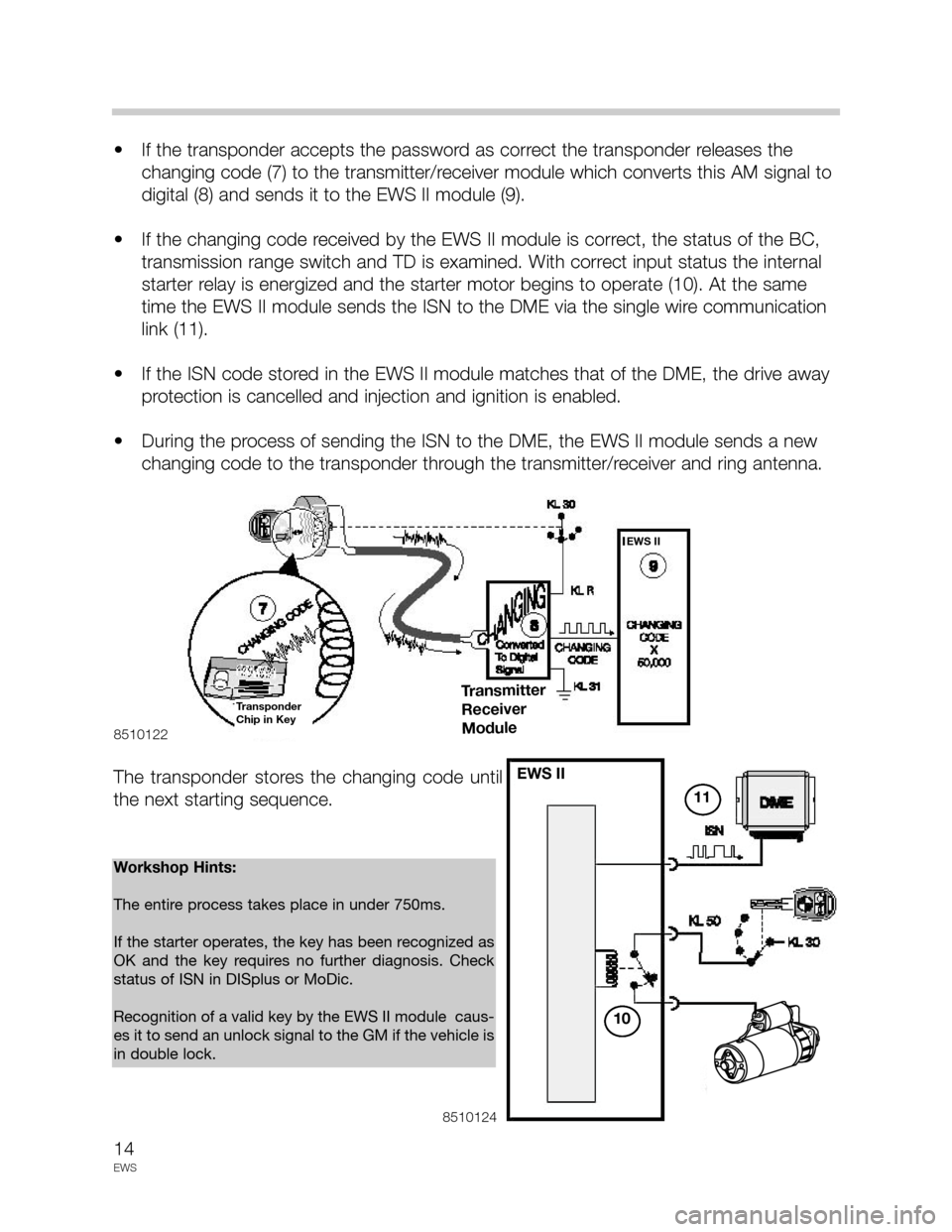
14
EWS
• If the transponder accepts the password as correct the transponder releases the
changing code (7) to the transmitter/receiver module which converts this AM signal to
digital (8) and sends it to the EWS II module (9).
• If the changing code received by the EWS II module is correct, the status of the BC,
transmission range switch and TD is examined. With correct input status the internal
starter relay is energized and the starter motor begins to operate (10). At the same
time the EWS II module sends the ISN to the DME via the single wire communication
link (11).
• If the ISN code stored in the EWS II module matches that of the DME, the drive away
protection is cancelled and injection and ignition is enabled.
• During the process of sending the ISN to the DME, the EWS II module sends a new
changing code to the transponder through the transmitter/receiver and ring antenna.
The transponder stores the changing code until
the next starting sequence.
8510122
8510124
10
11
Workshop Hints:
The entire process takes place in under 750ms.
If the starter operates, the key has been recognized as
OK and the key requires no further diagnosis. Check
status of ISN in DISplus or MoDic.
Recognition of a valid key by the EWS II module caus-
es it to send an unlock signal to the GM if the vehicle is
in double lock.
Transponder
Chip in KeyTransmitter
Receiver
Module
EWS II
EWS II
Page 15 of 30
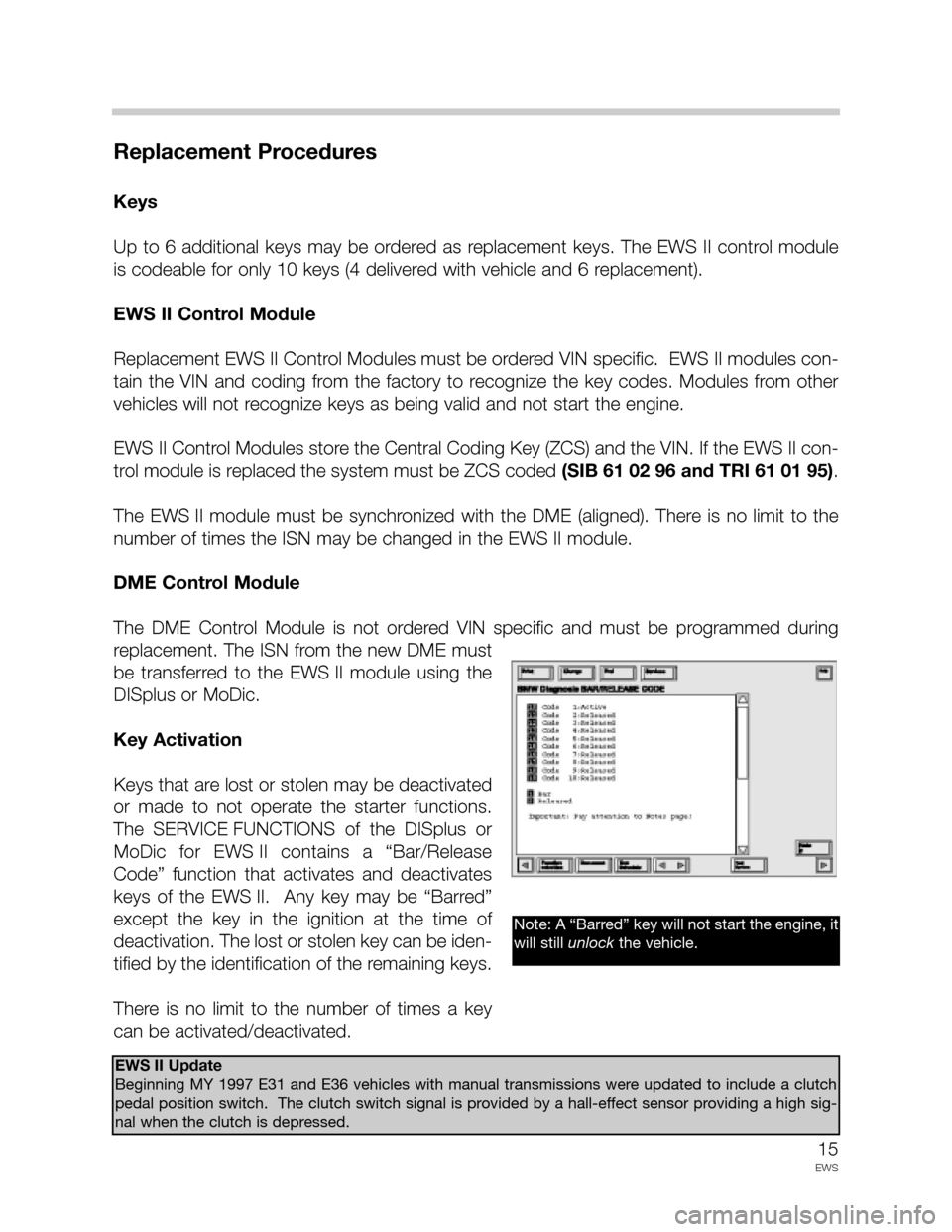
15
EWS
Replacement Procedures
Keys
Up to 6 additional keys may be ordered as replacement keys. The EWS II control module
is codeable for only 10 keys (4 delivered with vehicle and 6 replacement).
EWS II Control Module
Replacement EWS II Control Modules must be ordered VIN specific. EWS II modules con-
tain the VIN and coding from the factory to recognize the key codes. Modules from other
vehicles will not recognize keys as being valid and not start the engine.
EWS II Control Modules store the Central Coding Key (ZCS) and the VIN. If the EWS II con-
trol module is replaced the system must be ZCS coded (SIB 61 02 96 and TRI 61 01 95).
The EWS II module must be synchronized with the DME (aligned). There is no limit to the
number of times the ISN may be changed in the EWS II module.
DME Control Module
The DME Control Module is not ordered VIN specific and must be programmed during
replacement. The ISN from the new DME must
be transferred to the EWS II module using the
DISplus or MoDic.
Key Activation
Keys that are lost or stolen may be deactivated
or made to not operate the starter functions.
The SERVICE FUNCTIONS of the DISplus or
MoDic for EWS II contains a “Bar/Release
Code” function that activates and deactivates
keys of the EWS II. Any key may be “Barred”
except the key in the ignition at the time of
deactivation. The lost or stolen key can be iden-
tified by the identification of the remaining keys.
There is no limit to the number of times a key
can be activated/deactivated.
EWS II Update
Beginning MY 1997 E31 and E36 vehicles with manual transmissions were updated to include a clutch
pedal position switch. The clutch switch signal is provided by a hall-effect sensor providing a high sig-
nal when the clutch is depressed.
Note: A “Barred” key will not start the engine, it
will still unlockthe vehicle.
Page 16 of 30
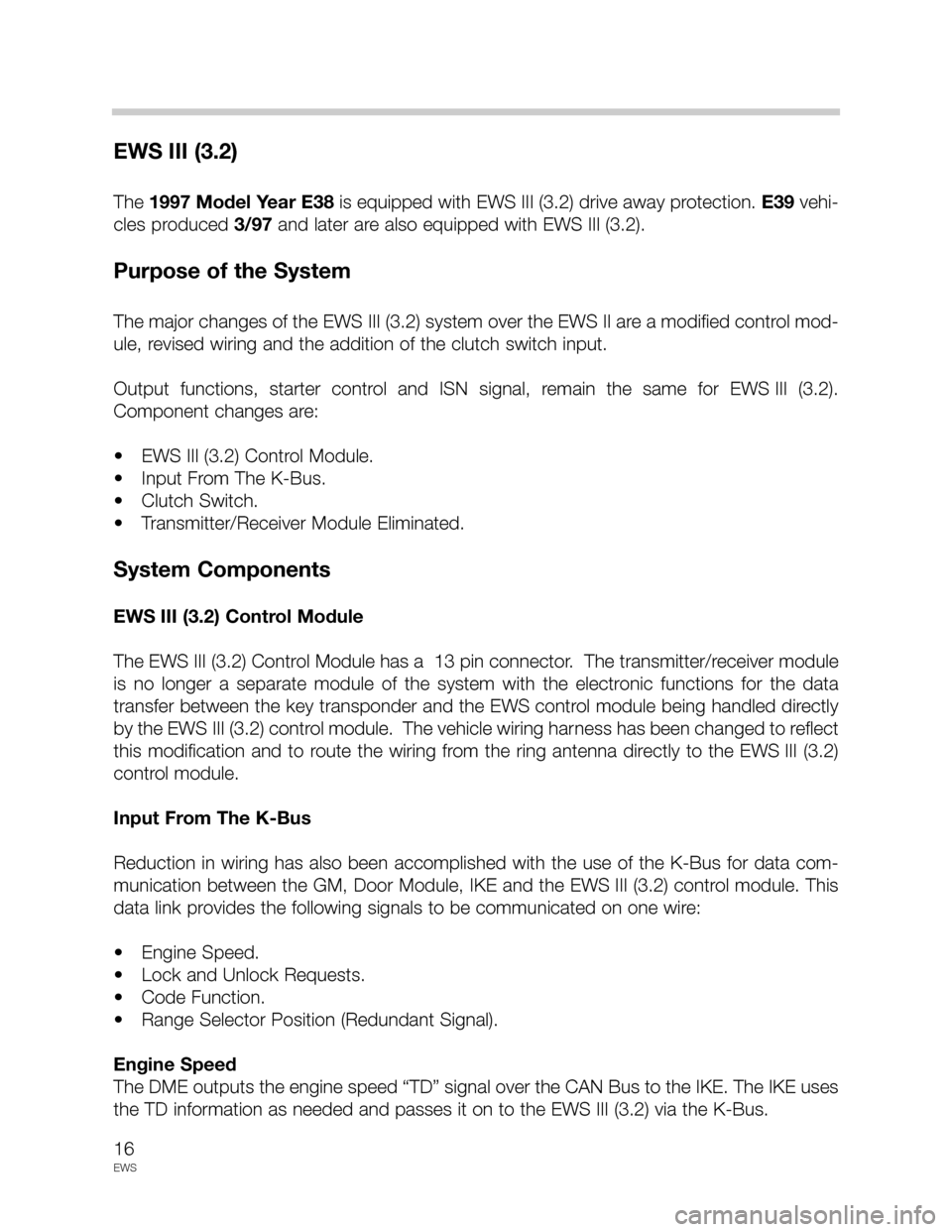
16
EWS
EWS III (3.2)
The 1997 Model Year E38is equipped with EWS III (3.2) drive away protection. E39vehi-
cles produced 3/97and later are also equipped with EWS III (3.2).
Purpose of the System
The major changes of the EWS III (3.2) system over the EWS II are a modified control mod-
ule, revised wiring and the addition of the clutch switch input.
Output functions, starter control and ISN signal, remain the same for EWS III (3.2).
Component changes are:
• EWS III (3.2) Control Module.
• Input From The K-Bus.
• Clutch Switch.
• Transmitter/Receiver Module Eliminated.
System Components
EWS III (3.2) Control Module
The EWS III (3.2) Control Module has a 13 pin connector. The transmitter/receiver module
is no longer a separate module of the system with the electronic functions for the data
transfer between the key transponder and the EWS control module being handled directly
by the EWS III (3.2) control module. The vehicle wiring harness has been changed to reflect
this modification and to route the wiring from the ring antenna directly to the EWS III (3.2)
control module.
Input From The K-Bus
Reduction in wiring has also been accomplished with the use of the K-Bus for data com-
munication between the GM, Door Module, IKE and the EWS III (3.2) control module. This
data link provides the following signals to be communicated on one wire:
• Engine Speed.
• Lock and Unlock Requests.
• Code Function.
• Range Selector Position (Redundant Signal).
Engine Speed
The DME outputs the engine speed “TD” signal over the CAN Bus to the IKE. The IKE uses
the TD information as needed and passes it on to the EWS III (3.2) via the K-Bus.
Page 17 of 30
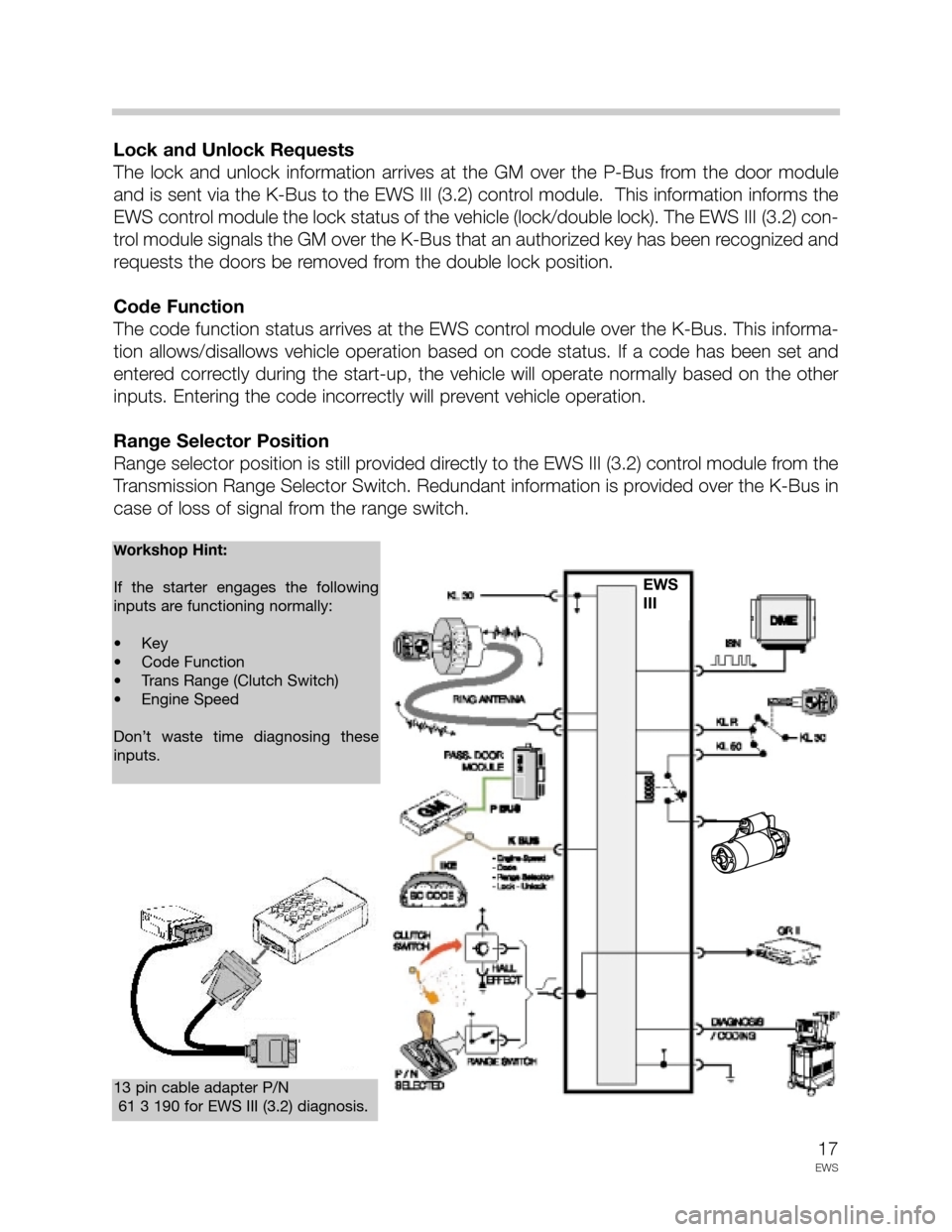
17
EWS
Lock and Unlock Requests
The lock and unlock information arrives at the GM over the P-Bus from the door module
and is sent via the K-Bus to the EWS III (3.2) control module. This information informs the
EWS control module the lock status of the vehicle (lock/double lock). The EWS III (3.2) con-
trol module signals the GM over the K-Bus that an authorized key has been recognized and
requests the doors be removed from the double lock position.
Code Function
The code function status arrives at the EWS control module over the K-Bus. This informa-
tion allows/disallows vehicle operation based on code status. If a code has been set and
entered correctly during the start-up, the vehicle will operate normally based on the other
inputs. Entering the code incorrectly will prevent vehicle operation.
Range Selector Position
Range selector position is still provided directly to the EWS III (3.2) control module from the
Transmission Range Selector Switch. Redundant information is provided over the K-Bus in
case of loss of signal from the range switch.
13 pin cable adapter P/N
61 3 190 for EWS III (3.2) diagnosis.
Workshop Hint:
If the starter engages the following
inputs are functioning normally:
• Key
• Code Function
• Trans Range (Clutch Switch)
• Engine Speed
Don’t waste time diagnosing these
inputs
.
EWS
III
Page 18 of 30
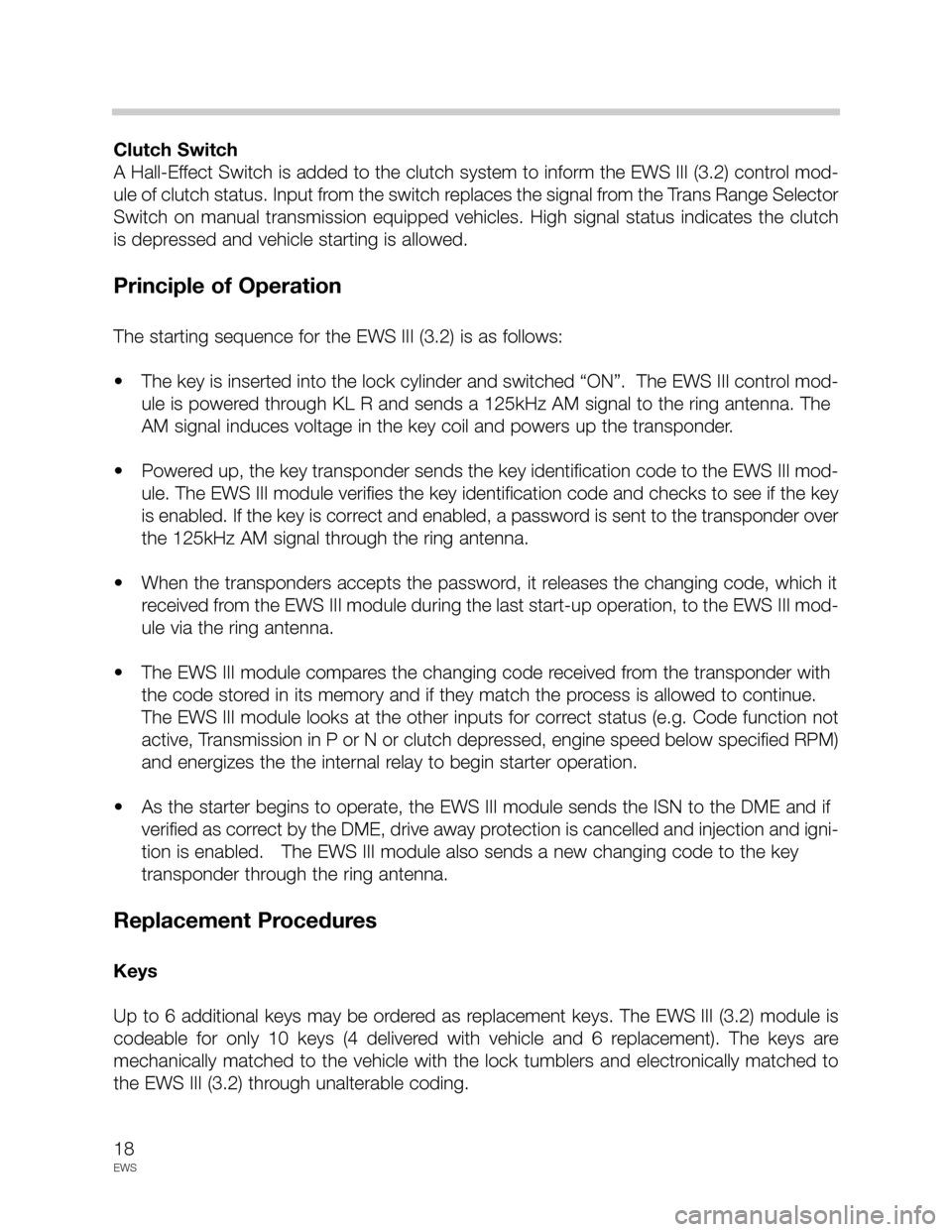
18
EWS
Clutch Switch
A Hall-Effect Switch is added to the clutch system to inform the EWS III (3.2) control mod-
ule of clutch status. Input from the switch replaces the signal from the Trans Range Selector
Switch on manual transmission equipped vehicles. High signal status indicates the clutch
is depressed and vehicle starting is allowed.
Principle of Operation
The starting sequence for the EWS III (3.2) is as follows:
• The key is inserted into the lock cylinder and switched “ON”. The EWS III control mod-
ule is powered through KL R and sends a 125kHz AM signal to the ring antenna. The
AM signal induces voltage in the key coil and powers up the transponder.
• Powered up, the key transponder sends the key identification code to the EWS III mod-
ule. The EWS III module verifies the key identification code and checks to see if the key
is enabled. If the key is correct and enabled, a password is sent to the transponder over
the 125kHz AM signal through the ring antenna.
• When the transponders accepts the password, it releases the changing code, which it
received from the EWS III module during the last start-up operation, to the EWS III mod-
ule via the ring antenna.
• The EWS III module compares the changing code received from the transponder with
the code stored in its memory and if they match the process is allowed to continue.
The EWS III module looks at the other inputs for correct status (e.g. Code function not
active, Transmission in P or N or clutch depressed, engine speed below specified RPM)
and energizes the the internal relay to begin starter operation.
• As the starter begins to operate, the EWS III module sends the ISN to the DME and if
verified as correct by the DME, drive away protection is cancelled and injection and igni-
tion is enabled. The EWS III module also sends a new changing code to the key
transponder through the ring antenna.
Replacement Procedures
Keys
Up to 6 additional keys may be ordered as replacement keys. The EWS III (3.2) module is
codeable for only 10 keys (4 delivered with vehicle and 6 replacement). The keys are
mechanically matched to the vehicle with the lock tumblers and electronically matched to
the EWS III (3.2) through unalterable coding.
Page 19 of 30
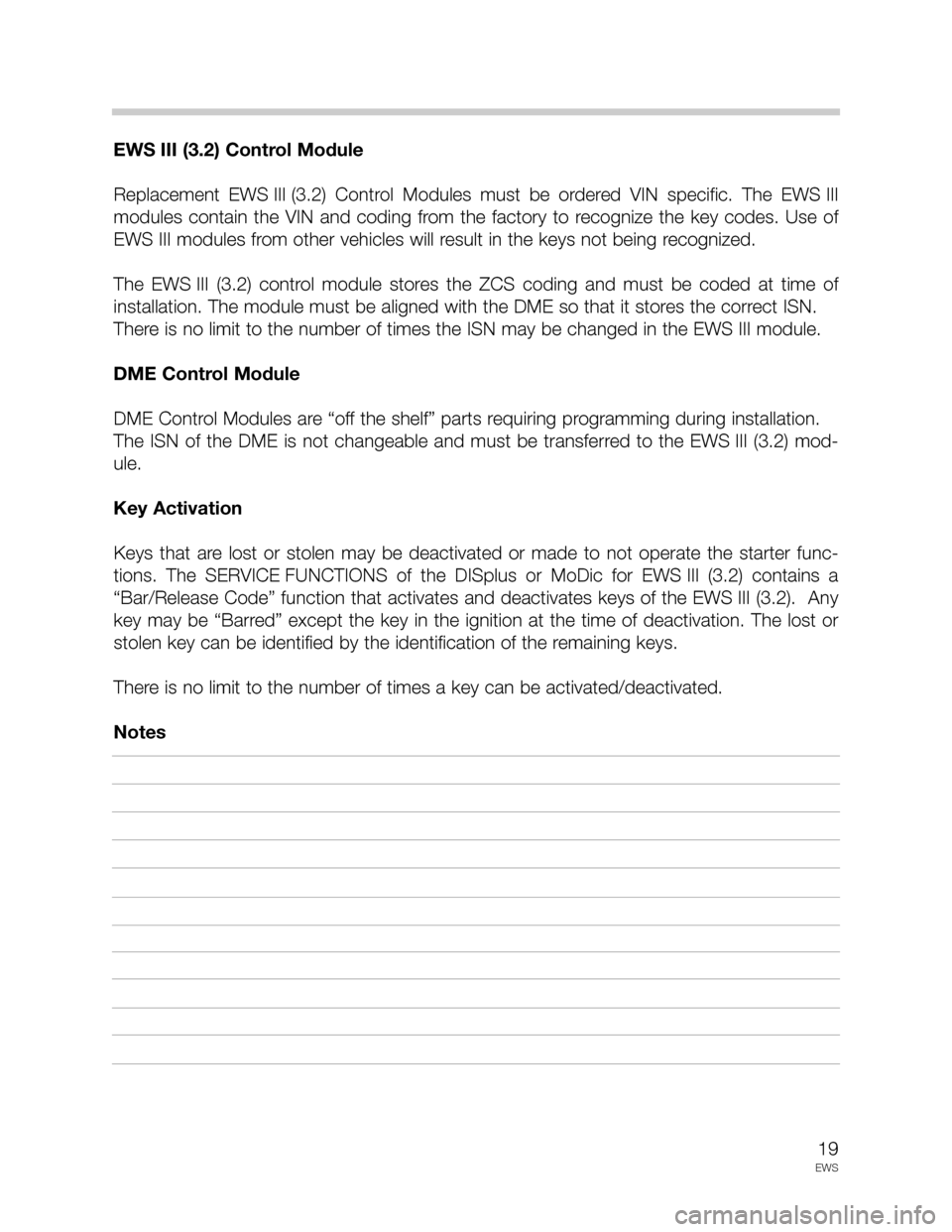
19
EWS
EWS III (3.2) Control Module
Replacement EWS III (3.2) Control Modules must be ordered VIN specific. The EWS III
modules contain the VIN and coding from the factory to recognize the key codes. Use of
EWS III modules from other vehicles will result in the keys not being recognized.
The EWS III (3.2) control module stores the ZCS coding and must be coded at time of
installation. The module must be aligned with the DME so that it stores the correct ISN.
There is no limit to the number of times the ISN may be changed in the EWS III module.
DME Control Module
DME Control Modules are “off the shelf” parts requiring programming during installation.
The ISN of the DME is not changeable and must be transferred to the EWS III (3.2) mod-
ule.
Key Activation
Keys that are lost or stolen may be deactivated or made to not operate the starter func-
tions. The SERVICE FUNCTIONS of the DISplus or MoDic for EWS III (3.2) contains a
“Bar/Release Code” function that activates and deactivates keys of the EWS III (3.2). Any
key may be “Barred” except the key in the ignition at the time of deactivation. The lost or
stolen key can be identified by the identification of the remaining keys.
There is no limit to the number of times a key can be activated/deactivated.
Notes
Page 20 of 30
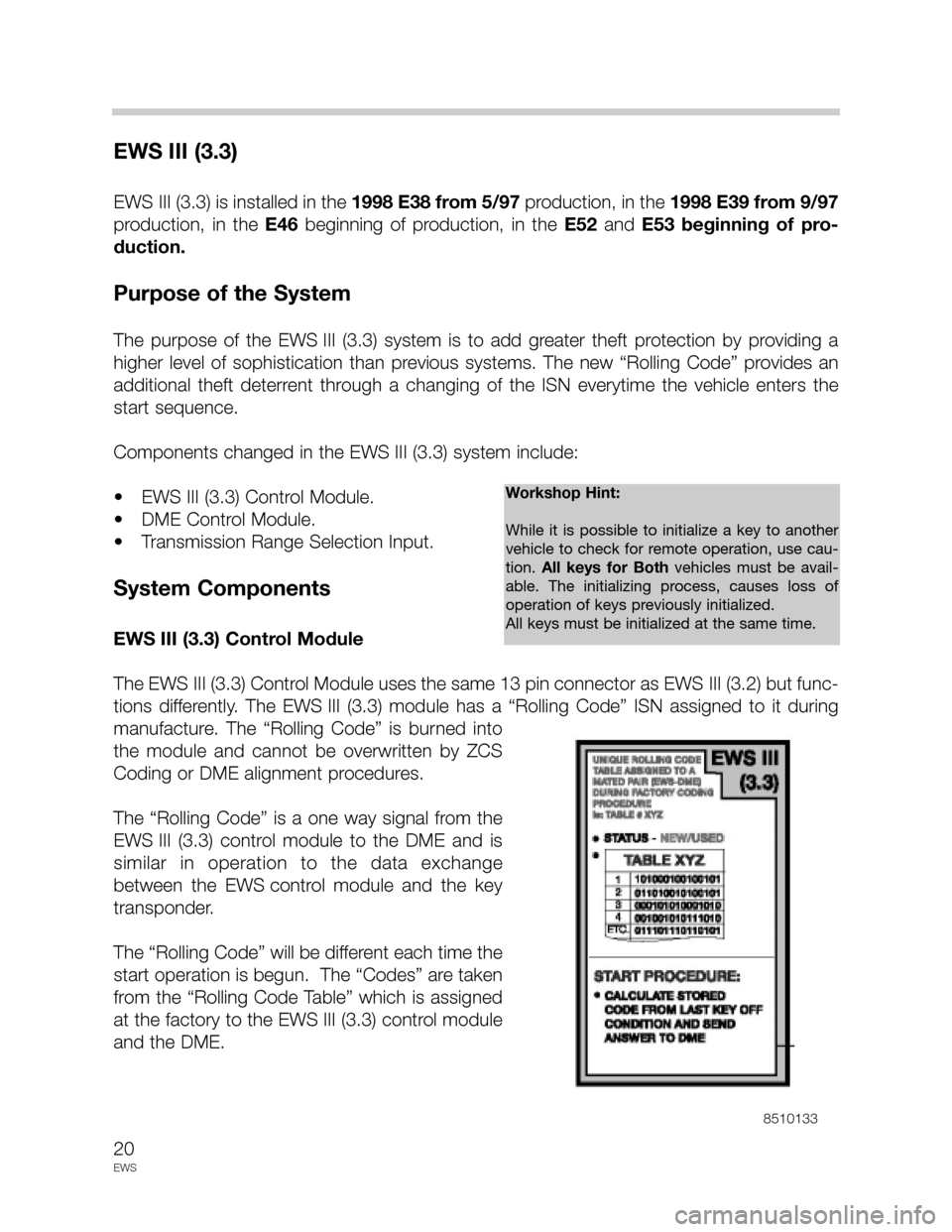
20
EWS
EWS III (3.3)
EWS III (3.3) is installed in the 1998 E38 from 5/97 production, in the 1998 E39 from 9/97
production, in the E46beginning of production, in the E52and E53 beginning of pro-
duction.
Purpose of the System
The purpose of the EWS III (3.3) system is to add greater theft protection by providing a
higher level of sophistication than previous systems. The new “Rolling Code” provides an
additional theft deterrent through a changing of the ISN everytime the vehicle enters the
start sequence.
Components changed in the EWS III (3.3) system include:
• EWS III (3.3) Control Module.
• DME Control Module.
• Transmission Range Selection Input.
System Components
EWS III (3.3) Control Module
The EWS III (3.3) Control Module uses the same 13 pin connector as EWS III (3.2) but func-
tions differently. The EWS III (3.3) module has a “Rolling Code” ISN assigned to it during
manufacture. The “Rolling Code” is burned into
the module and cannot be overwritten by ZCS
Coding or DME alignment procedures.
The “Rolling Code” is a one way signal from the
EWS III (3.3) control module to the DME and is
similar in operation to the data exchange
between the EWS control module and the key
transponder.
The “Rolling Code” will be different each time the
start operation is begun. The “Codes” are taken
from the “Rolling Code Table” which is assigned
at the factory to the EWS III (3.3) control module
and the DME.
8510133
Workshop Hint:
While it is possible to initialize a key to another
vehicle to check for remote operation, use cau-
tion. All keys for Bothvehicles must be avail-
able. The initializing process, causes loss of
operation of keys previously initialized.
All keys must be initialized at the same time.